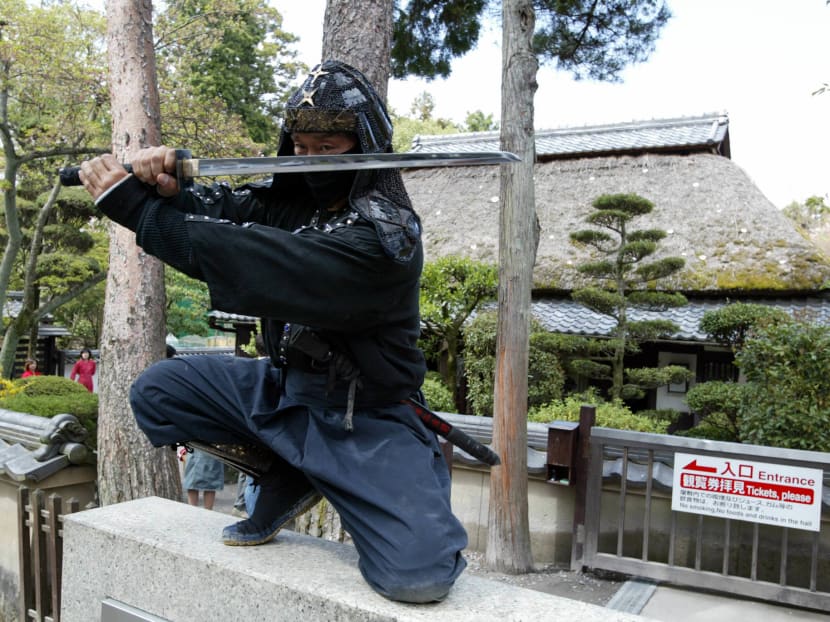Ninja emerges from shadows as Japan takes aim at tourism boom
IGA (Japan) — Ninja, Japan’s feudal mercenaries, are mainly known abroad as the stuff of legend and intrigue, while modern-day incarnations mainly in Asia have gained widespread popular appeal through media such as anime and manga, or games and movies.

AFP file photo
IGA (Japan) — Ninja, Japan’s feudal mercenaries, are mainly known abroad as the stuff of legend and intrigue, while modern-day incarnations mainly in Asia have gained widespread popular appeal through media such as anime and manga, or games and movies.
But tourists travelling to Japan who wish to familiarise themselves with the lore of this covert clan can find its heart and soul in a museum located in Iga, Mie Prefecture, dedicated to the history of the ninja.
For Japan, which seeks to boost the number of foreign travellers in the lead up to the 2020 Tokyo Olympics and Paralympics and help stimulate local economies, it presents a destination of choice and a win-win for the region and tourists alike.
Ninja employed covert techniques called ninjutsu and were involved in such missions as espionage, sabotage and assassination, before gradually diminishing in Japan’s Edo period (1603-1868).
“We are very interested in ninja for its culture and this is a very good place,” said Mr Ashish Jha, 28, of India, who lives in Suzuka, Mie Prefecture, where he conducts job training. He recently watched a demonstration held onstage at the Ninja Museum of Igaryu with some of his colleagues.
He said even in India, “Ninja are famous for their fighting and hiding techniques.”
Occasionally using English, the performers in the group called Ashura demonstrated a series of techniques, including martial arts employing weapons featuring shuriken (Japanese concealed traditional weapons), blowguns and chains to attack enemies.
Mr Rishabh Malik, 27, who was among the visitors, rented a black ninja outfit and tried out a blowgun onstage. “Very good, I feel like a real ninja,” Mr Malik said.
Mr Hanzo Ukita, who led the performance, said his team’s performance is highly regarded among foreign guests who wish to learn about the roots of the feudal assassins. In turn, he said, the troupe’s objective is to portray the essence of the culture.
“I always feel a sense of responsibility that we must do what is correct to correctly convey Japanese culture,” Mr Ukita said.
The museum in central Japan attracted more than 200,000 visitors in the year through March 2016, with some 26,000, or 12.5 per cent, coming from abroad. Iga is home to one of the most famous two ninja clans, along with neighbouring Koka in Shiga Prefecture.
For young people, a major driving force that evokes images of the traditional Japanese culture is “Naruto,” a popular manga story which debuted in 1999 and featured an adolescent ninja who battles rivals and dreams of becoming the strongest ninja.
Many foreign visitors, in particular those from Asian regions, visit the city out of interest in ninja animation such as “Ninja Hattori-kun,” a story about a child ninja who helps an elementary school boy in Tokyo. It was aired in Japan in the 1980s and in other countries later on.
“I came here to see ninja by myself because I used to see them on TV when I was a child,” said Mr Hsu Chi-lun, 27, from Taiwan, referring to “Nintamarantaro,” an animation series about a trio of ninja schoolmates.
Riding the popularity of ninja at home and abroad, the Japan Ninja Council, composed of local governments and tourism associations, has recently launched a new project centring on tourism and ninja training.
“As we expect to have 40 million tourists come to Japan in 2020 and 60 million in 2030, we believe, by utilising ninja, we can convey the attractive points of local areas and contribute to revitalizing local economies,” said Mr Hiroshi Mizohata, the council’s deputy head, at a recent press conference in Tokyo.
Under the Nippon Ninja Project, the council plans to open a new facility next year in collaboration with the Iga museum in Tokyo’s Sumida Ward, whose Ryogoku area is also home to the Edo-Tokyo Museum and Ryogoku Kokugikan where professional sumo wrestlers compete three times a year.
In an attempt to spread the Japanese culture abroad, the council also seeks to set up a ninja academy for the purpose of nurturing “ninja ambassadors” to spread the culture throughout the world.
Mr Yuji Yamada, a professor at Mie University versed in ninja culture, and Mr Jinichi Kawakami, who is known as the 21st head of the Koka ninja clan and the “last ninja,” are working together to spearhead the project.
The council will soon release two kinds of travel packages, mainly for inbound tourists. One is a “circular tour” that will take tourists to several ninja-related spots in Japan for two days and one night, including Odawara and Nagano both in central Japan.
The other is a “stay tour,” which offers guests a chance to stay in a specific location for around a week to get a deeper understanding of the ninja culture of a particular region.
Mr Naoko Terada, a veteran travel journalist, hailed the move which she believes will provide an avenue for foreign travellers to experience more areas of Japan.
The ninja experience could help promote the Japan Tourism Agency’s so-called MICE events to attract the bulk of foreign visitors, Terada said. MICE stands for meetings, incentives, conferences, and events. It is a type of tourism in which large groups are brought together for a particular purpose.
“Wearing a ninja outfit and throwing shuriken is something unique to Japan,” said Mr Terada, adding it will be extremely effective for team-building among participants of a meeting, for example.
But Mr Terada also casts doubt on the plan to open a new facility, in particular in Tokyo, where many other tourist attractions exist. KYODO NEWS





